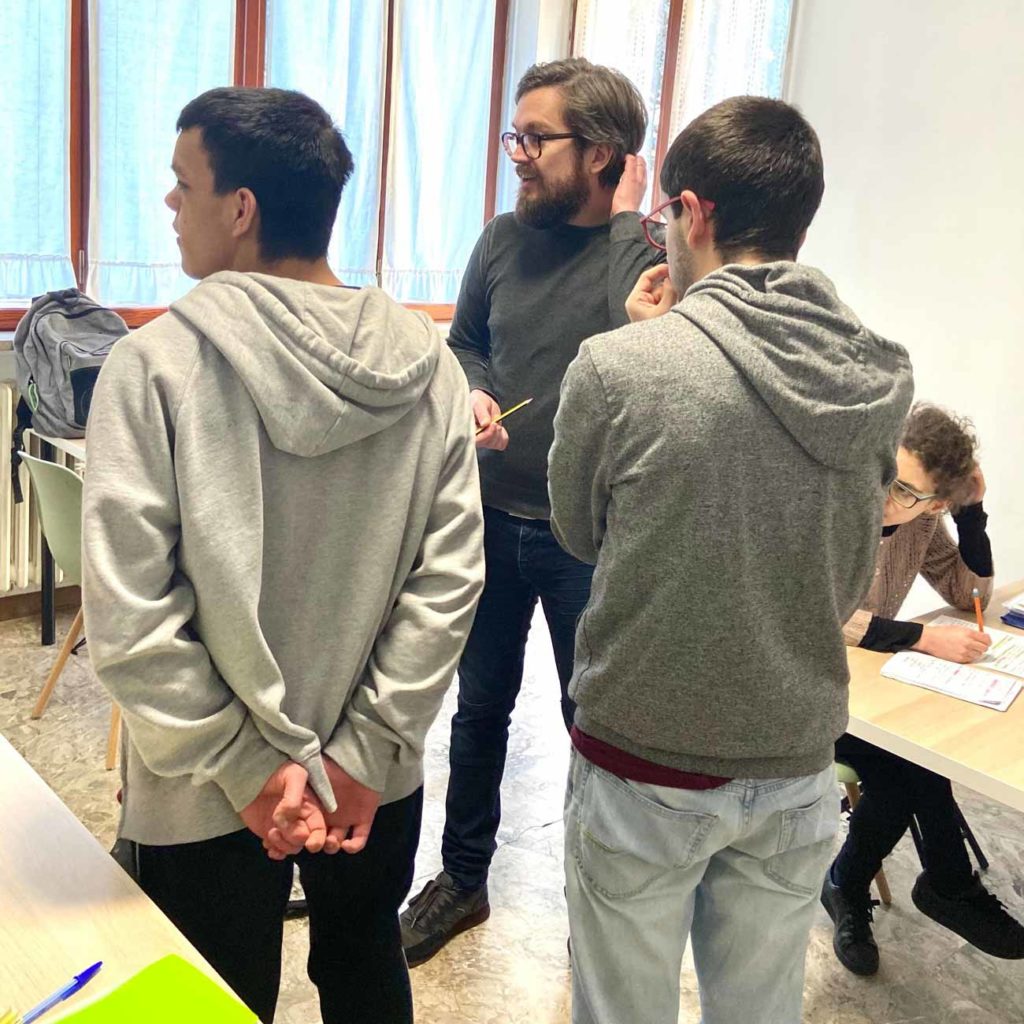The intellectual disability (disorder of intellectual development) is a disorder with onset in the developmental period that includes the deficit in the functioning of both intellectual to active in the areas of conceptual, social and practical.
In the past for this type of disorder you used the name “mental retardation” has been exceeded and will be replaced with this definition.
The intellectual functioning
The intellectual functioning refers to the mental capacity in general, such as reasoning, problem solving, planning, abstract thinking, judgment, learning, school, learning from the experience and practical understanding.
The measurement of intellectual functioning is typically made with a test of intelligence by which the administration will highlight the scores of IQ (intelligence quotient), for example, the Scale of Intelligence Wechsler. An intellectual functioning significantly below the average of at least two standard deviations is defined as an IQ of approximately 70 or below.
The scores obtained on the texts for the QI do not meet the diagnostic criteria, but should integrate the assessment of adaptive functioning-general of the subject.

The adaptive functioning

The adaptive functioning refers to the effectiveness with which the subjects are appropriate to the standards of personal independence expected for their particular age group, sociocultural background and environmental context.
The adaptive functioning involves the adequacy in three main areas.
- the conceptual sphere (educational) that involves skills in memory, language, reading, writing, in mathematical reasoning, problem solving and judgment in new situations.
- social that involves awareness of thoughts, feelings and experiences of others, empathy, communication skills, and ability in the relations of friendship.
- practical scope that involves the care of the self, the job responsibilities, money management, recreation, self-control of behavior and the organization of the tasks of school and work.
Severity levels
- MILD
- MODERATE
- SERIOUS
- EXTREME
Most (approximately 83-85%) of individuals with intellectual disabilities. The mild mental retardation in children, it is not immediately obvious, but it emerges, typically at the entrance to the primary school. From 0 to 5 years old develop social skills and communication skills and have a compromised minimum in the areas of sensory-motor. During adulthood, usually acquire social skills and employment adequate to a minimum level of self-reliance, but may be in need of support, especially when they are subjected to stress, social or economic unusual.
Regards 10-14% of the entire population of persons with intellectual disabilities. The acquisition of language and skills preschool occurs very slowly. Can benefit from the training in the social and business activities, they can learn to navigate it alone in familiar places. During adolescence, their difficulty in recognizing the social conventions can interfere in the relations with peers. In adulthood, the majority is able to develop non-specialised jobs, under supervision, in the secure work environments, or normal.
Constitutes 3-4% of the subjects with intellectual disability. During early childhood, these subjects acquire a minimum level of communicative language; the limits involving vocabulary and sentence construction: the verbal production is mainly composed of single words or simple phrases. During the school period, they may learn to talk and can be trained on the basic activities of the care of his person. In adulthood, they may be able to carry out simple tasks in highly secure environments. May be present behavior self-injurious.
Constitutes about 1-2% of individuals with intellectual disabilities. The majority of those who have this diagnosis has a neurological condition diagnosed that explains the disorder. During early childhood, show considerable impairment of the functioning of the sense-motor. They have a very limited understanding of communication: can understand some of the gestures or simple instructions and communicate through non-verbal. The individual is dependent on others in any aspect of the care of the physical, health, and safety daily, although it may be able to participate in some of these activities. Some can perform simple tasks in environments that are highly controlled and protected.
Prevalence, course and risk factors
prevalence
1% of the general population has an intellectual disability; it occurs in individuals of all races and all cultures. Overall, boys are more likely than females to receive this type of diagnosis, both in a mild form, which is severe.
L’debut takes place in the period of development: the age and characteristics of onset depend on the cause and severity of brain dysfunction. The delay in the stages of motor development, language and social can be identified within the first two years of life in patients with intellectual disability and more severe, while the disorder mild level may not be identified until school age.
course
On course play an important role in both the medical conditions general as well as the influence of environmental factors. Early intervention and ongoing, can improve the operation, the active throughout childhood and adulthood. In some cases, this leads to a significant improvement of the intellectual functioning such that the diagnosis of intellectual disability may not be the most appropriate. Therefore it is common practice in the assessment of young children, the delay in the diagnosis of intellectual disability after it has been made to the proper path of action. In older children and in adults, the extent of support provided can allow for the full participation in all activities of daily life and the improvement of the adaptive function.

risk factors
The causes prenatal include genetic syndromes (e.g. chromosomal diseases such as Down syndrome), inborn errors of metabolism, malformations of the brain diseases, maternal environmental influences (e.g. alcohol, drugs). The causes perinatal include a variety of events related to labor and childbirth that lead to encephalopathy, neonatal. The causes postnatal include hypoxic-ischemic, traumatic brain injury, infections, demyelinating disorders, compulsive disorders, deprivation, social, serious, and chronic syndromes, toxic-metabolic (e.g. lead, mercury).
As we act on intellectual disabilities Tice?
-
INTERVENTION, PSYCHOEDUCATIONAL BASED ON ABA
and COGNITIVE BEHAVIORAL THERAPY - INVOLVEMENT OF PARENTS
- NETWORKING
- SPEECH therapy
- NEUROPSICOMOTRICITÀ
L’Applied Behavior analysis (ABA) it is known for its effectiveness in intervention with persons with a disorder in the autism spectrum, but has been strong evidence to support its efficacy in the interventions with people with intellectual disabilities. From this, in fact, derive useful strategies to the teaching of communicative skills, education, and practices. To TICE, we have sections dedicated to children and young people with intellectual disabilities, which, depending on the age and level of severity, have the objective of maximizing the adaptive functioning in the different contexts of life. Each path of the intervention from a full in-depth rating (not diagnostic, but aimed to know the skills present in every individual), which allows you to individualize the path and define the objectives. Individuals with a good level of operation, can also be useful to support psycho emotional level courses in individual or group faces to the knowledge and expression of emotions) and social level (training of social skills in a group).
Sharing with the family is part of every step of the work to TICE: from the definition of the objectives, the sharing of strategies and data, the constant return of the trend of the path. In addition, there are courses structured in which the parent is invited to play on the sessions along with the professional in order to share the methods and strategies psicoeducative, routes, advice on whom to discuss these arrangements and the difficulties that emerge in different contexts and be supported by the emotional point of view.
Professionals TICE can make contact with all the actors that are part of the network of family support (SSN, school and other professionals), suggesting an the constant exchange and open, designed to maximize all the actions in the field. The school represents a fundamental place in which to implement strategies that maximize inclusion, creating culture in the students, learn skills useful for the growth. For this, we keep in constant contact with schools, through frequent meetings, meetings, supervisions, sharing of goals and programs, depending on the availability of the teacher and families.
Every child who attends TICE is in contact with speech and language therapistsdevelop in collaboration with the team objectives and programmes of work that are specific to the development of communication and language. The speech pathologist within Tice collects data on the intervention and share them with friends, colleagues and family and is an active part of theinterdisciplinary team psychologists, psicomotricisti and educationalists, leading to greater generalization and automation of competences is the object of the treatment.
Every child who attends TICE is in contact with neuropsicomotricistidevelop in collaboration with the team objectives and programmes of work that are specific to the development of the motility. The neuropsicomotricista within Tice collects data on the intervention and share them with friends, colleagues and family and is an active part of theinterdisciplinary team psychologists, speech therapists and educators, leading to greater generalization and automation of competences is the object of the treatment.
You respect in one of these descriptions?
You seem to see a relative or a friend of yours?
Contact us directly or fill out the form
THE SEAT OF CORREGGIO
THE SEE OF PIACENZA
Federica Berardo
Mobile phone: 339 6408830
Email federica.berardo@centrotice.it

